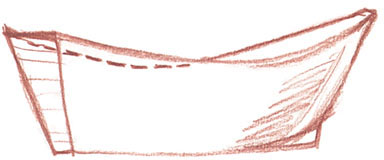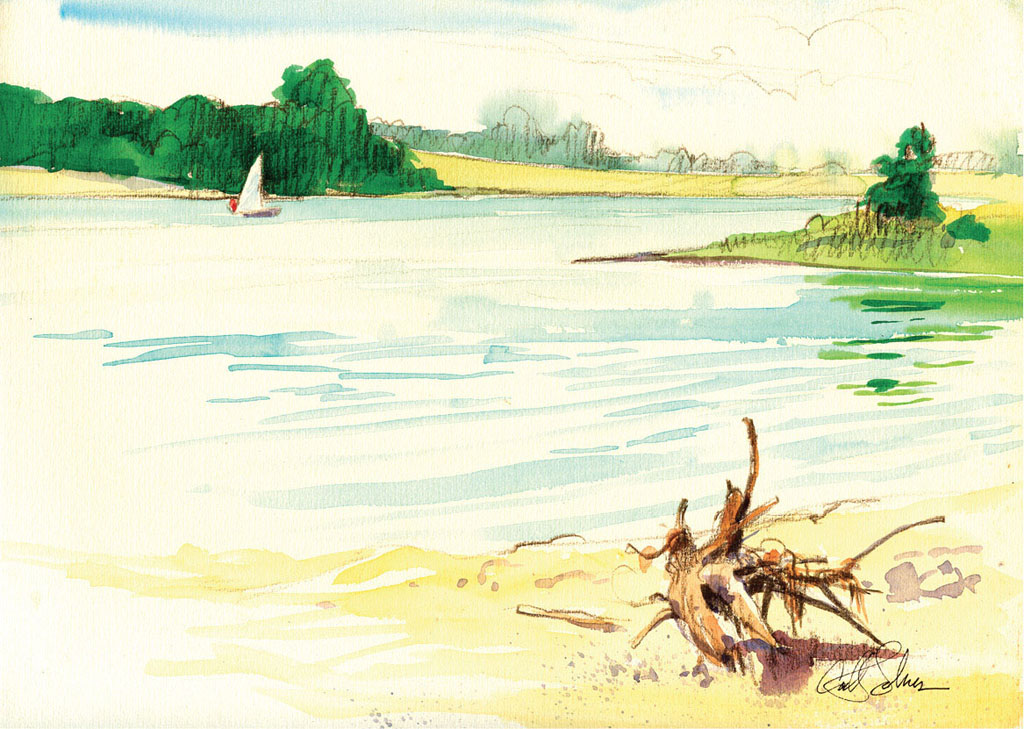
Watercraft are wonderfully satisfying—to watch, to travel in and to paint. They’re marvelous to paint from as well. They act almost as a kind of blind (or “hide,” as they say in Europe) to wildlife, which are much less likely to pay attention to you gliding by in a nearly silent canoe than if you approach on foot. Something about our telltale two-leggedness makes most creatures wary!
In the coastal regions, you’re liable to see boats everywhere—up on scaffolds, beached, bobbing in the water, on top of your neighbor’s car. Their shapes are endlessly fascinating. These forms look deceptively simple, but, in fact, they’re subtle, elegant and rather complex. When my love and I were at the Adirondack Museum, we visited the display of canoes and guideboats, and were blown out of the water (if you’ll excuse the pun!) by the delicate subtleties of shape that make all the difference in how a watercraft handles and what it’s intended to do. Even in the subcategory of “canoe,” you have whitewater craft, canoes for relatively still water, canoes stable enough for families and canoes for adventurous individuals—and more. Catch those shapes accurately, and your work will ring true!

Notice the sweep of the bow on this fishing boat and the follow-through indicated by the dotted line. That was very difficult to catch properly, but the shape makes it much more believable than if I hadn’t shown the tip of the bow rising above the gunwales.

SAILBOAT AT WATKINS
Watercolor on Fabriano cold-pressed watercolor paper
9" × 12" (23cm × 30cm)
If the boat is far enough away, you can barely see the people—in this case represented by the red dot of the windbreaker the sailor wore.

UP ON BLOCKS, PORT CLYDE, MAINE
Watercolor on hot-pressed watercolor paper
5" × 7" (13cm × 18cm)
I drew the shape of the boat and scaffolding as carefully as possible in pencil, then painted the negative shapes around it, first the trees in the background and the grass underneath. The background was a bold, varied mix of Phthalo Blue, Burnt Sienna and a bit of Yellow Ochre in the lighter green areas; the foreground leaned more heavily on Yellow Ochre and Cadmium Yellow Medium Hue in the mix.
Then I added the details of the scaffold, paying attention to lights and darks, and finally the shape of the boat itself. I tried to capture the roundness at the bow, especially, keeping values mostly light so the boat would stand out from the dark evergreens behind it. The deep dark shadow inside the boat gave it dimension.
You can use boats as smaller elements in your landscape or seascape. If they’re in the middle ground or distance, their shapes can be greatly simplified. Be aware, though, that the eye will be drawn directly to them, so do try to get those silhouettes right.